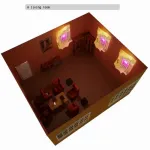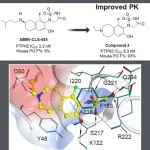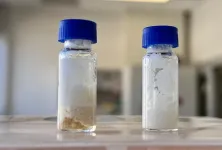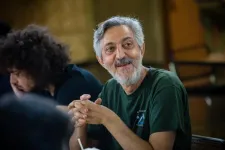(Press-News.org) Leuven (Belgium), 11 April 2024 — The role of the spinal cord is often simplified to that of a simple relay station, carrying messages between the brain and the body. However, the spinal cord can actually learn and remember movements on its own. A team of researchers at the Leuven-based Neuro-Electronics Research Flanders (NERF) details how two different neuronal populations enable the spinal cord to adapt and recall learned behavior in a way that is completely independent of the brain. These remarkable findings, published today in Science, shed new light on how spinal circuits might contribute to mastering and automating movement. The insights could prove relevant in the rehabilitation of people with spinal injuries.
The spinal cord’s puzzling plasticity
The spinal cord modulates and finetunes our actions and movements by integrating different sources of sensory information, and it can do so without input from the brain. What’s more, nerve cells in the spinal cord can learn to adjust various tasks autonomously, given sufficient repetitive practice. How the spinal cord achieves this remarkable plasticity, however, has puzzled neuroscientists for decades.
One such neuroscientist is Professor Aya Takeoka. Her team at Neuro-Electronics Research Flanders (NERF, a research institute backed by imec, KU Leuven and VIB) studies how the spinal cord recovers from injuries by exploring how the nerve connections are wired, and how they function and change when we learn new movements.
“Although we have evidence of ‘learning’ within the spinal cord from experiments dating back as early as the beginning of the 20th century, the question of which neurons are involved and how they encode this learning experience has remained unanswered,” says Prof. Takeoka.
Part of the problem is the difficulty in directly measuring the activity of individual neurons in the spinal cord in animals that are not sedated but awake and moving. Takeoka’s team took advantage of a model in which animals train specific movements within minutes. In doing so, the team uncovered a cell type-specific mechanism of spinal cord learning.
Two specific neuronal cell types
To check how the spinal cord learns, doctoral researcher Simon Lavaud and his colleagues at the Takeoka lab built an experimental setup to measure changes in movement in mice, inspired by methods used in insect studies. “We evaluated the contribution of six different neuronal populations and identified two groups of neurons, one dorsal and one ventral, that mediate motor learning.”
"These two sets of neurons take turns," explains Lavaud. "The dorsal neurons help the spinal cord learn a new movement, while the ventral neurons help it remember and perform the movement later."
"You can compare it to a relay race within the spinal cord. The dorsal neurons act like the first runner, passing on the critical sensory information for learning. Then, the ventral cells take the baton, ensuring the learned movement is remembered and executed smoothly."
Learning and memory outside the brain
The detailed results, published in this week’s edition of Science, illustrate that neuronal activity in the spinal cord resembles various classical types of learning and memory. Further unravelling these learning mechanisms will be crucial, as they likely contribute to different ways in which we learn and automate movement, and may also be relevant in the context of rehabilitation, says Prof. Aya Takeoka:
“The circuits we described could provide the means for the spinal cord to contribute to movement learning and long-term motor memory, which both help us to move, not only in normal health but especially during recovery from brain or spinal cord injuries.”
Publication
Two inhibitory neuronal classes govern acquisition and recall of spinal sensorimotor adaptation. Lavaud, et al. Science, 2024. DOI: 10.1126/science.adf6801
The research (team) was supported by the Research Foundation Flanders (FWO), Marie Skłodowska-Curie Actions (MSCA), a Taiwan-KU Leuven PhD fellowship (P1040), and the Wings for Life Spinal Cord Research Foundation.
END
Wired to learn and remember
New research unveils how spinal cord nerve cells can learn and remember—completely independent of the brain
2024-04-11
ELSE PRESS RELEASES FROM THIS DATE:
Penn Engineers recreate Star Trek’s Holodeck using ChatGPT and video game assets
2024-04-11
In Star Trek: The Next Generation, Captain Picard and the crew of the U.S.S. Enterprise leverage the holodeck, an empty room capable of generating 3D environments, to prepare for missions and to entertain themselves, simulating everything from lush jungles to the London of Sherlock Holmes. Deeply immersive and fully interactive, holodeck-created environments are infinitely customizable, using nothing but language: the crew has only to ask the computer to generate an environment, and that space appears in the holodeck.
Today, virtual interactive environments are also used to train robots prior to real-world deployment in a ...
UC Santa Cruz researchers value salt marsh restoration as a crucial tool in flood risk reduction and climate resilience in the San Francisco Bay
2024-04-11
Salt marsh restoration can mitigate flood risk and bolster community resilience to climate change in our local waterways, according to a recent study published in Nature by a postdoctoral fellow with UC Santa Cruz’s Center for Coastal Climate Resilience (CCCR).
The study, titled “The value of marsh restoration for flood risk reduction in an urban estuary,” explores the social and economic advantages of marsh restoration amidst the growing threats of sea level rise and storm-driven flooding. Climate change will put many communities at risk. In California, some of the study co-authors from the U.S. Geological ...
Insilico Medicine develops novel PTPN2/N1 inhibitor for cancer immunotherapy using generative AI
2024-04-11
In recent years, cancer immunotherapy, exemplified by PD-1 and its ligand PD-L1 blockade, has made remarkable advances. But while immunotherapy drugs offer new treatment possibilities, only about 20% to 40% of patients respond to these treatments. The majority either don't respond or develop drug resistance. Researchers are now looking for ways to enhance the scope of tumor immunotherapy in order to benefit a wider range of patients.
One such avenue is through the protein tyrosine phosphatase non-receptor type 2 (PTPN2) and its close superfamily member, PTPN1, identified in previous research as crucial modulators involved in the regulation ...
$318 million New York City community parks initiative is associated with increased use of urban parks in low-income neighborhoods
2024-04-11
A new study in JAMA Network Open led by researchers from the CUNY Graduate School of Public Health and Health Policy observed 28,322 park users across 54 neighborhood parks and found a clear association between park renovation and park use in low-income neighborhoods in New York City (NYC).
As the global trend toward urbanization continues, two thirds of the world’s population is predicted to live in cities by 2050. Amid the noise, stress, and crowding of city life, urban parks have the potential to provide opportunities for physical activity, mitigate heat and pollution, lower stress, and improve mental and social well-being, all of which can decrease the prevalence ...
Trapped in the middle: billiards with memory
2024-04-11
Adding one simple rule to an idealized game of billiards leads to a wealth of intriguing mathematical questions, as well as applications in the physics of living organisms. This week, researchers from the University of Amsterdam, including two master students as first authors – have published a paper in Physical Review Letters about the fascinating dynamics of billiards with memory.
Billiards: a mathematical mystery
An idealized version of the game of billiards has fascinated mathematicians for decades. The basic ...
A new spin on organic shampoo makes it sudsier, longer lasting
2024-04-11
While there’s no regulation in the U.S. for what’s in organic shampoos, they tend to contain ingredients perceived as safe or environmentally friendly. However, these “clean” shampoos separate and spoil faster than those made with synthetic stabilizers and preservatives. Now, researchers in ACS Sustainable Chemistry & Engineering demonstrate that a simple process — spinning organic shampoo at high speeds — improved the final products’ shelf lives and ability to clean hair.
Natural emulsifiers, such as xanthan gum and cetyl alcohol, ...
Nanoscale movies shed light on one barrier to a clean energy future
2024-04-11
DURHAM, N.C. -- Left unchecked, corrosion can rust out cars and pipes, take down buildings and bridges, and eat away at our monuments.
Corrosion can also damage devices that could be key to a clean energy future. And now, Duke University researchers have captured extreme close-ups of that process in action.
“By studying how and why renewable energy devices break down over time, we might be able to extend their lifetime,” said chemistry professor and senior author Ivan Moreno-Hernandez.
In his lab at Duke sits a miniature version of one such device. Called an electrolyzer, ...
American College of Lifestyle Medicine announces first two medical schools to earn highest recognition and certification for lifestyle medicine curriculum
2024-04-11
The American College of Lifestyle Medicine (ACLM) has announced that the University of South Carolina School of Medicine Greenville (SOMG) and Loma Linda University School of Medicine (LLUSM) are the first to earn the highest recognition of a “Platinum Plus” certification designation for the significant level of undergraduate lifestyle medicine curricula within their programs.
The Platinum Plus is the highest tier of certification that a medical school can receive from ACLM and indicates the incorporation of at least 100 hours of evidence-based lifestyle medicine content within the curriculum. This level of lifestyle medicine ...
Avi Wigderson receives ACM A.M. Turing Award for groundbreaking insights on randomness
2024-04-11
ACM, the Association for Computing Machinery, today named Avi Wigderson as recipient of the 2023 ACM A.M. Turing Award for foundational contributions to the theory of computation, including reshaping our understanding of the role of randomness in computation, and for his decades of intellectual leadership in theoretical computer science.
Wigderson is the Herbert H. Maass Professor in the School of Mathematics at the Institute for Advanced Study in Princeton, New Jersey. He has been a leading figure in areas including computational complexity theory, algorithms and optimization, randomness and cryptography, parallel and distributed computation, combinatorics, and graph theory, as well as ...
NAWI awarded funding to continue to accelerate research and development for a secure water future
2024-04-11
– By Lauren Core
The National Alliance for Water Innovation (NAWI), which is led by the Department of Energy’s (DOE) Lawrence Berkeley National Laboratory (Berkeley Lab), has been extended for five more years with $75 million in funding from DOE. NAWI will continue its contributions to helping decarbonize the water and wastewater sectors through investments in technologies that enhance the efficient use of energy for water use, treatment, and distribution.
“Water and energy are interdependent – water is used to produce nearly every major energy source, and ...
LAST 30 PRESS RELEASES:
Numbers in our sights affect how we perceive space
SIMJ announces global collaborative book project in commemoration of its 75th anniversary
Air pollution exposure and birth weight
Obstructive sleep apnea risk and mental health conditions among older adults
How talking slows eye movements behind the wheel
The Ceramic Society of Japan’s Oxoate Ceramics Research Association launches new international book project
Heart-brain connection: international study reveals the role of the vagus nerve in keeping the heart young
Researchers identify Rb1 as a predictive biomarker for a new therapeutic strategy in some breast cancers
Survey reveals ethical gaps slowing AI adoption in pediatric surgery
Stimulant ADHD medications work differently than thought
AI overestimates how smart people are, according to HSE economists
HSE researchers create genome-wide map of quadruplexes
Scientists boost cell "powerhouses" to burn more calories
Automatic label checking: The missing step in making reliable medical AI
Low daily alcohol intake linked to 50% heightened mouth cancer risk in India
American Meteorological Society announces Rick Spinrad as 2026 President-Elect
Biomass-based carbon capture spotlighted in newly released global climate webinar recording
Illuminating invisible nano pollutants: advanced bioimaging tracks the full journey of emerging nanoscale contaminants in living systems
How does age affect recovery from spinal cord injury?
Novel AI tool offers prognosis for patients with head and neck cancer
Fathers’ microplastic exposure tied to their children’s metabolic problems
Research validates laboratory model for studying high-grade serous ovarian cancer
SIR 2026 delivers transformative breakthroughs in minimally invasive medicine to improve patient care
Stem Cell Reports most downloaded papers of 2025 highlight the breadth and impact of stem cell research
Oxford-led study estimates NHS spends around 3% of its primary and secondary care budget on the health impacts of heat and cold in England
A researcher’s long quest leads to a smart composite breakthrough
Urban wild bees act as “microbial sensors” of city health.
New study finds where you live affects recovery after a hip fracture
Forecasting the impact of fully automated vehicle adoption on US road traffic injuries
Alcohol-related hospitalizations from 2016 to 2022
[Press-News.org] Wired to learn and rememberNew research unveils how spinal cord nerve cells can learn and remember—completely independent of the brain




